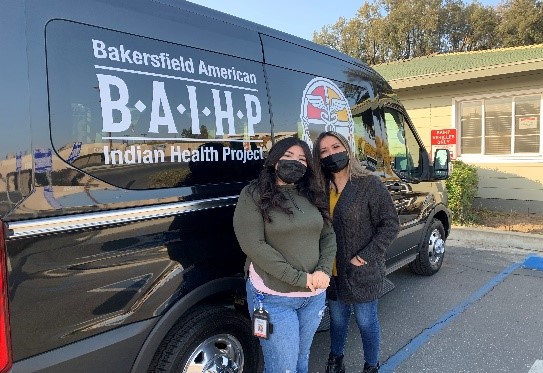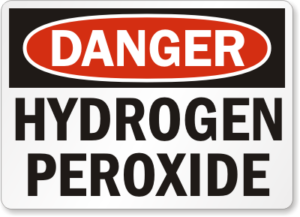UIO Highlight: Bakersfield American Indian Health Project
Vehicle Transportation Services – Cleaning and Disinfection
by Joseph Anderson, Bakersfield American Indian Health Project
Maintaining a clean and sanitary environment in our patient transport vehicles is essential to the success of our infection prevention and control program. It can be a real challenge to keep germs at bay when we are transporting various people and we know that inadequate decontamination efforts can leave enough germs to spread illness to others. At BAIHP, every qualified driver pays attention to both driver and passenger safety. We choose our decontamination tools and methods carefully. One of our best tools we use is a cordless UV-C Sanitizer that is a convenient and keeps everyone healthier by killing the bacteria and viruses that cause diseases. We find using this type of tool to be a safe and easy way to sanitize items such as: pens/pencils, smartphones, door handles, steering wheels, journal books, and more. We have also installed vehicle safety barriers designed to create a protective barrier between the front and rear seats to reduce the spread of coronaviruses via airborne particles in passenger cars, providing greater safety for drivers and passengers.
Proper cleaning and decontaminating frequently is a key health and safety measure. If a surface appears dirty, it should be wiped down with soap and water prior to disinfection. For vehicle interiors, a soft or microfiber cloth dampened with soap and water can also be used to wipe down hard surfaces. The interiors of some of our vehicles have various materials and surfaces so, the main thing we keep in mind while disinfecting our vehicles is that nothing gets damaged. Other than using a UV-C Sanitizer, we will use screen wipes, or a soft cloth dampened with soap and water to clean the screen surface. We do not use ammonia-based cleaners on infotainment screens because they can damage the anti-glare and anti-fingerprint coatings.
While most common household disinfectants are effective, some are not ideal for use on a vehicle including bleach, hydrogen peroxide, benzene, thinners, or other harsh and abrasive cleaners. These chemical products can damage a vehicle’s upholstery and/or interior surfaces. Instead, we follow the recommendation from the CDC and use alcohol-based wipes or sprays containing at least 70% alcohol.
Did you know that more than 700 different kinds of bacteria are living in the average vehicle?
SELECTING MATERIALS TO CLEAN AND DISINFECT YOUR VEHICLE’S INTERIOR:
Depending on whether our vehicles have cloth, imitation leather, or real leather upholstery, the cleaning agents and steps differ accordingly. We always follow the manufacturer’s instructions to ensure germs are killed. Each BAIHP’s driver understands the amount of time a disinfectant must remain visible wet on a surface to effectively kill a specific pathogen, so each disinfectant has enough time to kill the targeted pathogen before it gets wiped away. At BAIHP, we prefer to use Isopropyl alcohol as a safe option for most interior surfaces. Isopropyl alcohol with a strength of around 70% is easy and safe to use for wiping hard surfaces. These may include the dashboard, steering wheel, seat adjusters, console, doors, shifter, handles, knobs, gear shifter, seat belts, rearview mirror, cup-holders, etc. It is also suitable for cleaning imitation leather.
Isopropyl alcohol can remove various types of stains, residues, smudges, and kill viruses and bacteria. However, keep in mind that it is bad for leather. Leather has a thin coating that protects it from discoloration. Chemicals like Isopropyl alcohol can destroy the coating, fading the dye of the leather.
We prioritize the “high touch” surfaces of our vehicles when cleaning. All wiping is carried out using a microfiber cloth. This fabric has tiny loops that sweep and capture away dust and dirt particles before they scratch shiny plastic or delicate surfaces. So, not only will it effectively trap dirt, but it also ensures we leave no scratches while cleaning.
STEPS FOR DISINFECTING AND CLEANING VEHICLE INTERIORS
While automobile interiors are designed to be strong and durable, scrubbing them with something rough can cause discoloration and scratches. Wiping hard surfaces with alcohol and gently cleaning upholstery have been the most effective methods to clean and maintain our vehicles’ interior. We avoid using excess water when wiping seats to avoid getting absorbed through the cushion underneath, possible resulting in a musty smell and mold growth. Using a sponge or cloth soaked in soap water has been the best way for us to wipe down our vehicles’ seats.
No matter what you do, avoid using hydrogen peroxide and bleach to clean your vehicle’s interior. While they might be effective in killing coronaviruses, they can also damage the upholstery of your vehicle.
Experts commonly recommend that after cleaning and disinfecting a vehicle’s interior, you should make sure to wash your hands every time you enter the car. It will prevent the virus from getting on any surface of your vehicle and ensure it remains disinfected. Even without COVID-19, this is a healthy habit that also prevents your vehicle’s interior from getting too dirty. A car’s steering wheel probably has the most bacteria due to continuous touching. Washing hands before we drive helps to ensure our steering wheels remain in good condition.
WHAT IS IMPROPER USE OF DISINFECTANTS?
Using more than directed on the label, mixing multiple chemical products together, not wearing protective gear, and using in poorly ventilated areas are all improper ways to misuse disinfectants. To reduce improper use and prevent unnecessary chemical exposures, we always read and follow directions on the label, only use water at room temperature for dilution (unless stated otherwise on the label), avoid mixing chemical products, and wear eye and skin protection.
HIGH TOUCH SURFACES:
- Steering wheel
- Key and remote fob
- Exterior door handles, both sides
- Trunk lid or lift gate grab areas
- Interior door pulls, both sides and interior door panels
- Start button, if equipped
- Rear view mirror, back and edges
- HVAC vents
- Gear selector
- Turn signal lever
- Windshield wiper controls
- Center stack knobs
- Center console and arm rest
- Seat belt and buckle
- Parking brake handle, parking brake or release lever








